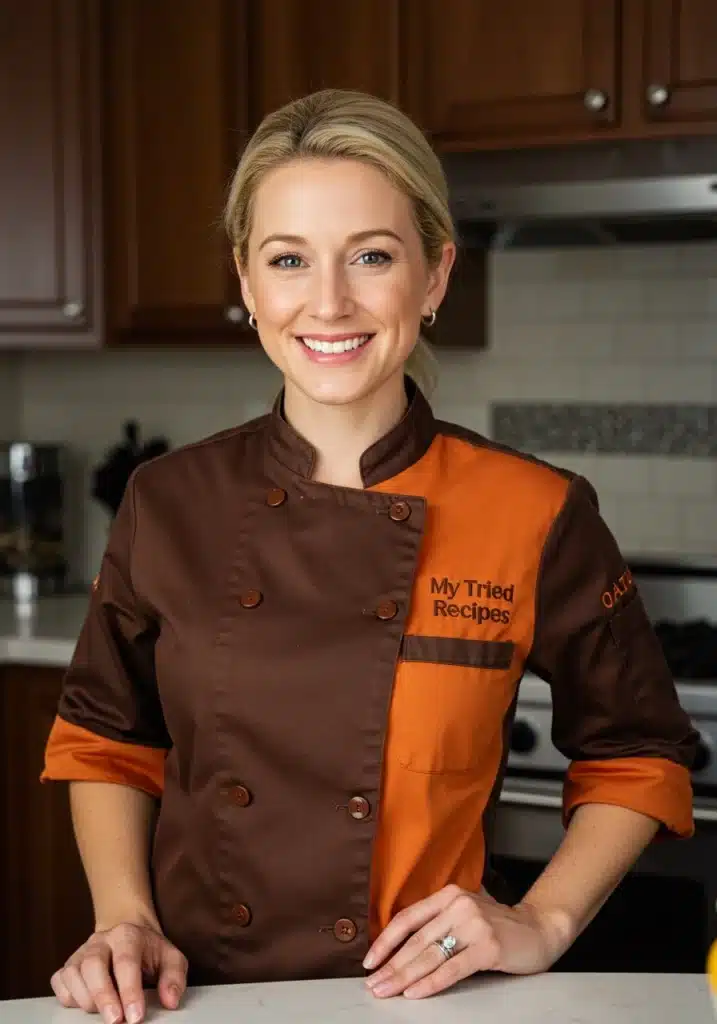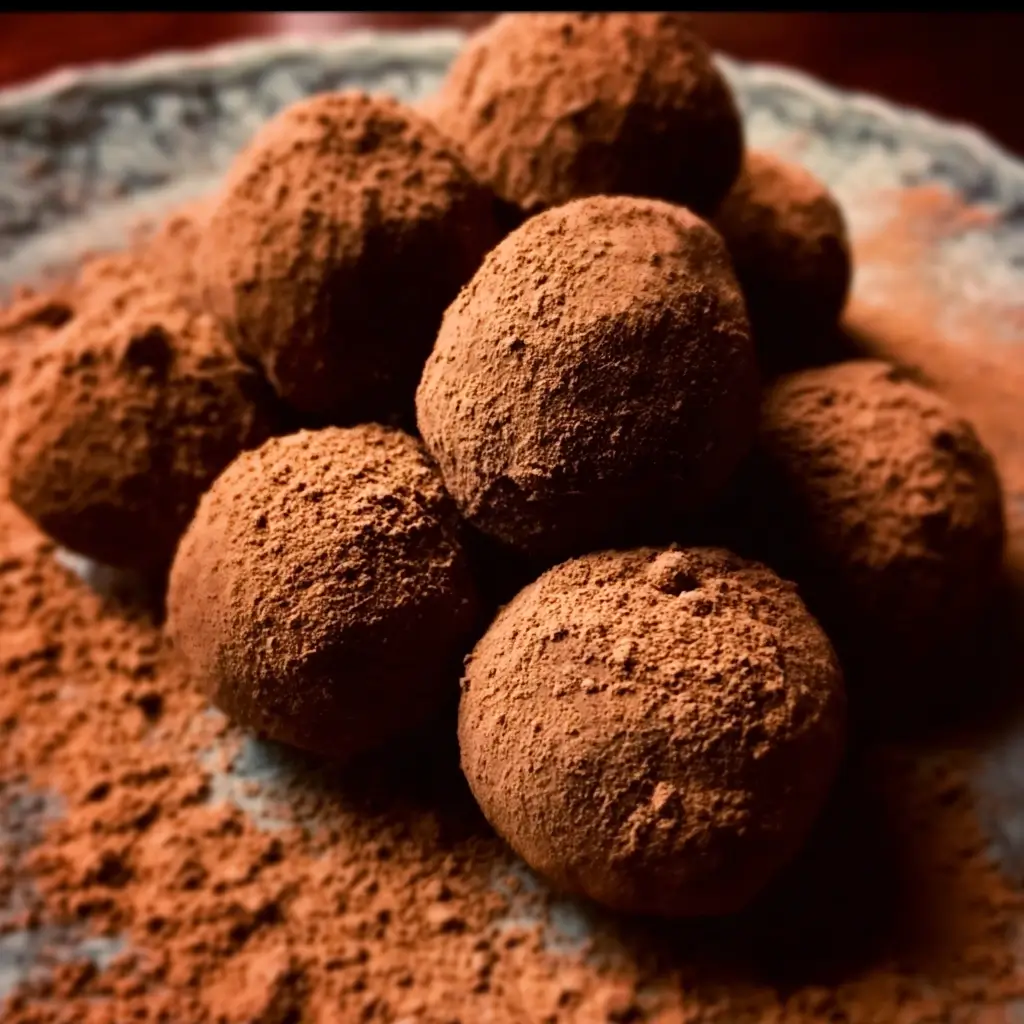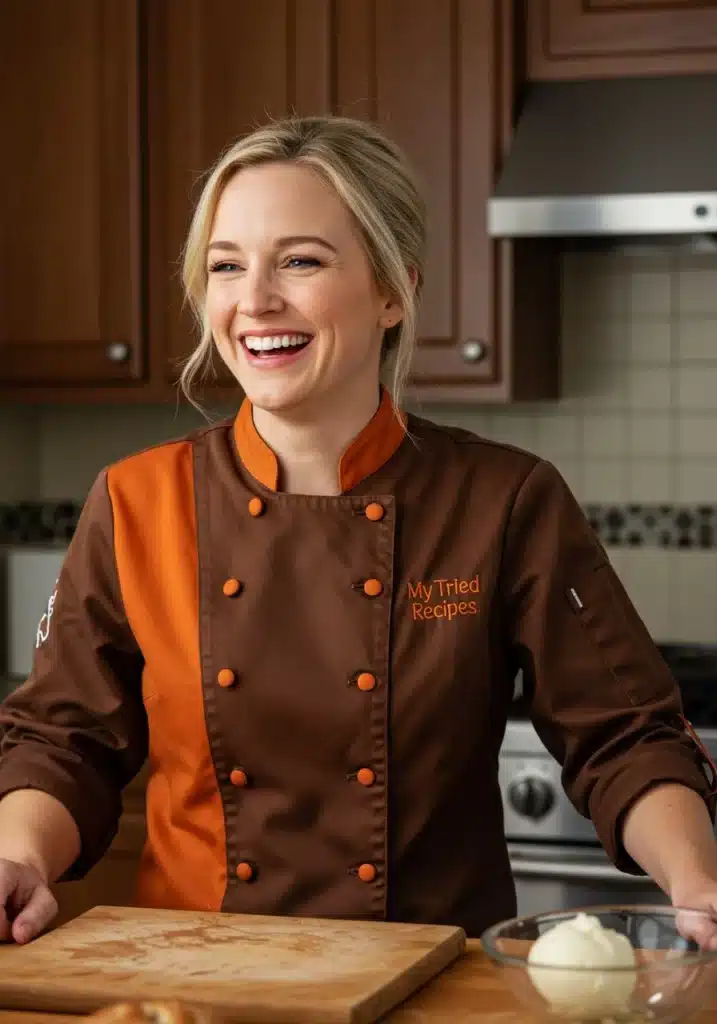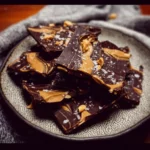Of all the desserts in my culinary repertoire, none bring me as much joy and elicit as many “wows” as these deceptively simple 3-ingredient chocolate truffles. I remember the first time I made them. I was hosting a last-minute dinner party, and my grand dessert plans had fallen through. In a quiet panic, I scoured my pantry and found a bar of good-quality dark chocolate and a carton of heavy cream. A quick search led me to a basic ganache recipe, and with a dash of vanilla extract, I had my three ingredients. I was skeptical. Could something so simple truly be special? An hour later, as I rolled the cool, silky ganache into little spheres and dusted them with cocoa powder, I knew I had stumbled upon something magical. That evening, as my guests bit into them, the room fell silent for a moment, followed by a chorus of delight. They couldn’t believe they were homemade, let alone made with just three ingredients. These truffles have since become my signature treat—for holidays, hostess gifts, or just a Tuesday night indulgence. They are proof that you don’t need a pastry degree or a long list of fancy ingredients to create something truly luxurious and memorable.
The Magic of Simplicity: Why This 3-Ingredient Recipe is a Game-Changer
In a world filled with complex recipes and intimidating techniques, the beauty of a three-ingredient dish is undeniable. But these chocolate truffles are more than just simple; they represent a return to the core of what makes a dessert incredible: quality ingredients and a touch of care. Here’s why this recipe will become your new go-to for every occasion.
- Effortless Elegance: The final product looks and tastes like something you’d find in a high-end chocolatier’s display case. They are rich, decadent, and sophisticated, yet the process is so straightforward that a complete beginner can achieve perfect results on their first try.
- Budget-Friendly Luxury: Sourcing gourmet truffles can be an expensive affair. By making them at home, you control the cost without sacrificing quality. You can create dozens of truffles for the price of a small box from a specialty store, making them an accessible indulgence.
- Infinitely Customizable: This recipe is a perfect canvas for your creativity. The basic three ingredients—chocolate, cream, and a flavor enhancer—are just the beginning. As we’ll explore later, you can infuse the cream, add different extracts, or roll the truffles in a vast array of coatings to create unique flavor profiles every time.
- The Perfect Make-Ahead Dessert: Life is busy, and recipes that can be prepared in advance are a lifesaver. The ganache for these truffles needs time to chill, making them an ideal dessert to prep a day or two before a party or event. This frees you up to focus on other things when it matters most.
- A Wonderful Homemade Gift: There is nothing more thoughtful than a homemade gift. A beautifully packaged box of these chocolate truffles is a heartfelt present for holidays, birthdays, or as a simple “thank you.” It’s a gift that says you cared enough to create something special with your own hands.
Understanding Your Three Core Ingredients: The Foundation of Perfection
With only three components, the quality of each one is paramount. There’s nowhere for a sub-par ingredient to hide. Understanding what each element brings to the recipe will not only guarantee success but also empower you to experiment with confidence.
The Star of the Show: Choosing Your Chocolate
This is the most important decision you will make. The chocolate defines the flavor, texture, and overall character of your truffles.
- Type of Chocolate: For a classic, rich truffle, semi-sweet or bittersweet chocolate with a cacao percentage between 60% and 72% is ideal. This range provides a deep, robust chocolate flavor that balances beautifully with the richness of the cream. Milk chocolate can also be used, but it will result in a much sweeter truffle and a softer ganache that may require more chilling time. White chocolate works as well, creating a sweet, creamy truffle that pairs wonderfully with flavors like lemon zest, raspberry, or matcha.
- Quality Matters: This is the time to skip the standard chocolate chips meant for cookies. They often contain stabilizers that prevent them from melting smoothly, which can lead to a grainy or waxy ganache. Instead, opt for high-quality chocolate bars (like Ghirardelli, Lindt, Scharffen Berger, or Valrhona) or chocolate callets (discs) designed for melting. You can usually find these in the baking aisle of your grocery store.
- Chopping is Key: Regardless of the form, you must chop the chocolate finely and uniformly. The smaller the pieces, the more quickly and evenly they will melt when the hot cream is added. This is the single most important step to prevent the chocolate from seizing and ensuring a silky-smooth ganache.
The Silky Secret: Heavy Cream Explained
Heavy cream, or heavy whipping cream, is the second non-negotiable ingredient. It’s the liquid that melts the chocolate and the fat that gives the truffles their signature creamy, melt-in-your-mouth texture.
- Fat Content is Crucial: Heavy cream in the United States must contain at least 36% milkfat. This high fat content is essential for creating a stable emulsion with the chocolate. Do not substitute this with half-and-half, whole milk, or light cream. These lower-fat alternatives do not have enough fat to bind with the chocolate properly and will likely result in a runny, soupy ganache that will never set into a firm, rollable consistency.
- The Science of Ganache: When you pour hot cream over chocolate, you are creating an emulsion. The fat from the cream and the cocoa butter from the chocolate are suspended together by the liquid. This delicate balance is what gives ganache its unique texture—solid and firm when chilled, yet soft and melting at body temperature.
The Flavor Enhancer: Your Third Magical Ingredient
While chocolate and cream form the body of the truffle, the third ingredient gives it its soul. This is where you can add a layer of complexity and personality.
- Classic Choice (Vanilla Extract): A teaspoon of pure vanilla extract is the most common and beloved choice. It doesn’t make the truffles taste overtly of vanilla; instead, it rounds out and enhances the deep notes of the chocolate, making it taste more complex and “chocolaty.”
- For the Coffee Lover (Espresso Powder): A teaspoon of instant espresso powder dissolved in the hot cream will work wonders. Like vanilla, it amplifies the chocolate flavor without necessarily tasting like a mocha. It adds an incredible depth and cuts through some of the richness.
- A Touch of Sophistication (Liqueurs): Adding a tablespoon of your favorite liqueur can elevate these truffles to a gourmet level. Consider dark rum, brandy, Grand Marnier (orange), Chambord (raspberry), or Kahlúa (coffee). Be sure to add the liqueur after the ganache has been mixed and has cooled slightly, as adding alcohol to a very hot mixture can cause it to curdle.
Ingredients
- 8 ounces (225g) High-Quality Semi-Sweet or Bittersweet Chocolate: Use a baking bar or callets, not chocolate chips. This forms the rich, flavorful base of your truffles.
- 2/3 cup (160ml) Heavy Whipping Cream: The high fat content is essential for creating a smooth, stable, and creamy ganache.
- 1 teaspoon Pure Vanilla Extract: This is our third ingredient, which enhances and deepens the natural flavor of the chocolate. You can substitute with other flavorings like espresso powder or a tablespoon of liqueur.
- Unsweetened Cocoa Powder, for rolling (optional): This classic coating provides a beautiful finish and a pleasant, slightly bitter contrast to the rich truffle.
Instructions
- Prepare the Chocolate: Finely chop the chocolate bar into small, uniform pieces. If you’re using chocolate callets or discs, you can skip this step. Place the chopped chocolate in a medium-sized, heat-proof bowl and set it aside. This is a crucial step; finely chopped chocolate will melt evenly and prevent a grainy ganache.
- Heat the Cream: Pour the heavy cream into a small saucepan. Heat it over medium heat, watching it carefully. You want the cream to come to a gentle simmer, with small bubbles forming around the edges of the pan. Do not let it come to a rolling boil, as overly hot cream can cause the chocolate to “split” or become oily.
- Combine Cream and Chocolate: Once the cream is simmering, immediately remove it from the heat and pour it directly over the prepared chopped chocolate. Do not stir it yet. Gently nudge the bowl to ensure all the chocolate is submerged in the hot cream.
- Let it Rest (The Magic Moment): Let the bowl sit undisturbed for 5 minutes. This is a critical pause. It allows the gentle, residual heat of the cream to melt the chocolate slowly and completely from the inside out. Resisting the urge to stir immediately is the secret to a perfectly smooth ganache.
- Stir to Perfection: After 5 minutes, add the vanilla extract to the center of the mixture. Begin stirring slowly from the center of the bowl in small circles, gradually working your way out to the edges. At first, the mixture might look broken or grainy, but keep stirring gently. Suddenly, it will transform into a smooth, dark, and glossy emulsion. This is your ganache.
- Chill the Ganache: Cover the bowl with plastic wrap, pressing the wrap directly onto the surface of the ganache to prevent a skin from forming. Place the bowl in the refrigerator to chill until firm enough to scoop. This typically takes 1 to 2 hours.
- Scoop and Roll: Once the ganache is firm, it’s time to form the truffles. Place your chosen coating (e.g., cocoa powder) in a shallow dish. Use a small cookie scoop or a melon baller (about 1 tablespoon size) to portion out the ganache. Quickly roll each portion between your palms to form a smooth ball. The heat from your hands will melt the ganache slightly, so work efficiently.
- Coat the Truffles: Immediately drop the rolled truffle into your dish of cocoa powder (or other coating) and roll it around until it is completely covered. Place the finished truffle on a parchment-lined baking sheet or plate. Repeat with the remaining ganache.
- Final Chill: Once all truffles are rolled and coated, you can serve them immediately, or for a firmer texture, let them chill in the refrigerator for another 30 minutes before serving.
Mastering the Ganache: The Heart of Your Truffles
Ganache is more than just melted chocolate and cream; it’s a delicate emulsion that can sometimes be finicky. Understanding how to handle it and troubleshoot common issues will make you a truffle-making pro. The ideal ratio for firm, rollable truffles is typically 2 parts chocolate to 1 part cream by weight (e.g., 8 ounces of chocolate to 4 ounces, or 1/2 cup, of cream). Our recipe uses slightly more cream for a creamier, softer center, which is why the chilling step is so important.
Troubleshooting Common Ganache Problems
- Split or Oily Ganache: If your ganache looks greasy, separated, or curdled, it has “split.” This usually happens if the cream was too hot or if it was over-mixed. The Fix: Don’t panic! Gently warm 1-2 tablespoons of milk or more heavy cream (do not boil it). Add it to your split ganache and whisk vigorously. The extra liquid will help the fat and solids re-emulsify, bringing your ganache back to a smooth, glossy state.
- Grainy Ganache: A grainy texture is almost always caused by the chocolate not melting completely before being stirred. This happens if the chocolate pieces were too big or the cream wasn’t quite hot enough. The Fix: Create a makeshift double boiler. Place your ganache bowl over a saucepan of simmering water (don’t let the bottom of the bowl touch the water) and stir gently and constantly until the grainy bits have melted and the mixture is smooth. Be careful not to overheat it, or it may split.
- Ganache is Too Soft to Roll: If after 2 hours of chilling the ganache is still too soft, your kitchen might be warm, or your chocolate-to-cream ratio was slightly off. The Fix: Simply let it chill for longer. Give it another hour or two in the fridge. In a pinch, you can place it in the freezer for 15-20 minute intervals, stirring in between, until it reaches a scoopable consistency.
The Fun Part: Rolling and Customizing Your Truffles
The final coating is what gives your truffles their visual appeal and an extra layer of flavor and texture. While classic cocoa powder is divine, the possibilities are endless.
Creative Coating Ideas to Elevate Your Truffles
- Powders:
- Unsweetened Cocoa Powder: The timeless classic.
- Powdered Sugar: For a sweeter, “snowy” look.
- Matcha Green Tea Powder: For a unique, earthy flavor and stunning color.
- Finely Ground Freeze-Dried Berries: Raspberry or strawberry powder adds a tart, fruity kick and a vibrant pink hue.
- Nuts & Seeds:
- Finely Chopped Toasted Nuts: Almonds, pecans, hazelnuts, or pistachios add a wonderful crunch. Toasting them first deepens their flavor.
- Shredded Coconut: Toasted or untoasted, it adds a lovely chewiness.
- Sesame Seeds: Toasted sesame seeds provide a nutty, savory contrast.
- Sweet & Crunchy:
- Chocolate or Rainbow Sprinkles (Jimmies): A fun, festive option perfect for celebrations.
- Nonpareils: For a classic, crunchy texture.
- Crushed Peppermint Candies: A perfect choice for the holiday season.
- Finely Crushed Cookies: Oreo crumbs or Biscoff cookie crumbs are delicious options.
- Gourmet Finishes:
- Flaky Sea Salt (like Maldon): Just a tiny sprinkle on top of a plain or cocoa-dusted truffle balances the sweetness and enhances the chocolate flavor.
- Dipping in Melted Chocolate: For a true chocolatier experience, dip the chilled truffle balls in melted dark, milk, or white chocolate for a hard outer shell.
Nutrition Facts
- Servings: 20-24 truffles
- Calories per serving (1 truffle): Approximately 95-110 kcal
- Fat: Approximately 8g. The majority comes from the cocoa butter in the chocolate and the heavy cream, providing the rich, satisfying mouthfeel.
- Carbohydrates: Approximately 7g. Primarily from the sugar content in the semi-sweet chocolate.
- Protein: Approximately 1g. A small amount derived from both the chocolate and the cream.
Disclaimer: Nutritional information is an estimate and can vary depending on the specific brands of chocolate and cream used.
Preparation Time
- Active Time: 20 minutes (chopping chocolate, heating cream, and rolling)
- Chilling Time: 1.5 – 2.5 hours
- Total Time: Approximately 2 – 3 hours
This recipe is low on active effort but requires patience during the chilling phase to achieve the perfect texture for rolling.
How to Serve Your Homemade Chocolate Truffles
These versatile treats can be presented in numerous ways to suit any occasion.
- As a Dessert Platter Centerpiece: Arrange the truffles on a beautiful platter, perhaps mixing different coatings for visual variety. They are the perfect bite-sized dessert to serve after a heavy meal.
- With Coffee or Tea: The intense flavor of a dark chocolate truffle is the perfect companion to a strong cup of espresso, coffee, or a robust black tea. Serve one or two alongside an after-dinner coffee.
- As a Gourmet Gift:
- Purchase small candy boxes or tins from a craft store.
- Line the box with mini cupcake liners or candy cups.
- Place one truffle in each liner to prevent them from sticking together.
- Tie the box with a beautiful ribbon for a professional and heartfelt gift.
- On a Charcuterie or “Dessert-cuterie” Board: Add a small bowl of truffles to a sweet or savory board. They pair wonderfully with cheeses, fruits like figs and berries, and various nuts.
- Crumbled Over Ice Cream: For an ultra-decadent treat, roughly chop a truffle and sprinkle it over a scoop of vanilla bean or coffee ice cream.
Additional Tips for Truffle Triumph
- Temperature is Everything: Ensure your ingredients aren’t at extreme temperature differences (aside from the hot cream). If your chocolate is ice-cold from the fridge, let it come to room temperature first to promote even melting.
- Use a Scoop for Uniformity: A small cookie scoop (about 1-2 teaspoons) is your best friend for this recipe. It ensures all your truffles are a consistent size, which helps them look professional and chill evenly.
- Wear Gloves: Rolling ganache can be a messy business. Wearing food-safe disposable gloves can help keep your hands clean and also prevent the heat from your hands from melting the truffles too quickly.
- Work in Batches: If your kitchen is warm, the ganache can soften rapidly. Keep the main bowl of ganache in the refrigerator and only take out enough to roll 4-5 truffles at a time.
- Infuse Your Cream: For a more subtle flavor infusion, you can gently heat the cream with flavor agents like a cinnamon stick, a few sprigs of fresh mint, or a split vanilla bean. Let it steep for 15-20 minutes, then strain the cream before reheating it to a simmer and pouring over the chocolate.
- Don’t Rush the Chill: The most common mistake is trying to roll the ganache before it’s fully firm. Be patient. If it’s sticky and unmanageable, it simply needs more time in the refrigerator.
- Storage is Simple: Store your finished truffles in an airtight container in the refrigerator. They will stay fresh for up to two weeks.
- Serve at Room Temperature: For the best flavor and texture, remove the truffles from the refrigerator about 20-30 minutes before serving. This allows them to soften slightly, so they melt perfectly in your mouth.
Frequently Asked Questions (FAQ)
1. Can I use milk chocolate or white chocolate instead of dark?
Yes, you can! However, milk and white chocolate contain more milk solids and sugar and less cocoa mass, which makes the ganache much softer. To compensate, you will need to adjust the chocolate-to-cream ratio. A good starting point for a rollable ganache is 3 parts milk/white chocolate to 1 part cream by weight (e.g., 9 ounces of chocolate to 3 ounces of cream).
2. Can I make these truffles vegan or dairy-free?
Absolutely. For a vegan version, use a high-quality dairy-free dark chocolate (check the label to ensure no milk products are included). For the cream, substitute the heavy cream with full-fat canned coconut cream. Use only the thick, solidified cream from the top of a chilled can, not the watery liquid at the bottom. The result is incredibly rich and delicious.
3. Why did my ganache split and how can I fix it?
A split (oily or separated) ganache is usually caused by the fat separating from the rest of the ingredients. This can happen if the cream was too hot, the mixture was agitated too much, or due to extreme temperature shocks. To fix it, whisk in 1-2 tablespoons of warm (not hot) milk or more cream until the mixture comes back together into a smooth emulsion.
4. How long do these truffles last and how should I store them?
Store the truffles in an airtight container in the refrigerator. Because they contain fresh dairy, they should be refrigerated. They will stay fresh and delicious for up to 2 weeks.
5. Can I freeze chocolate truffles?
Yes, they freeze beautifully! Place the finished truffles on a baking sheet in a single layer and freeze until solid. Then, transfer them to a freezer-safe bag or airtight container. They can be frozen for up to 3 months. To thaw, simply move them to the refrigerator for a few hours before serving.
6. My ganache is too hard to scoop from the fridge. What do I do?
If the ganache has become rock-solid, just let it sit at room temperature for 20-30 minutes. It will soften up enough to become scoopable. Don’t try to microwave it, as you risk melting it unevenly and splitting the ganache.
7. What is the best and easiest way to finely chop the chocolate bar?
Use a large, sharp serrated knife (like a bread knife). It will grip the chocolate and allow you to “shave” it into small, thin pieces and shards much more easily and safely than a standard chef’s knife.
8. Are these chocolate truffles gluten-free?
Yes, as long as you use pure chocolate, cream, and vanilla, this recipe is naturally gluten-free. Always double-check the labels of your chocolate and any coatings (like crushed cookies) if you are serving someone with a severe gluten allergy or celiac disease.
Conclusion: Your New Favorite Indulgence
Creating something truly decadent doesn’t need to be a day-long, complicated affair. This 3-ingredient chocolate truffle recipe is a testament to the power of quality and simplicity. It’s a recipe that invites you to slow down, to enjoy the process—the satisfying chop of the chocolate, the magical moment the ganache comes together, the simple joy of rolling a perfect sphere.
Whether you’re making them as a sophisticated dessert for guests, a heartfelt gift for a loved one, or a secret stash for yourself, these truffles deliver pure, unadulterated chocolate bliss. They are more than a recipe; they are an experience, a little piece of luxury you can create anytime you wish. So go ahead, grab that bar of good chocolate, and prepare to be amazed at what you and three simple ingredients can do.






